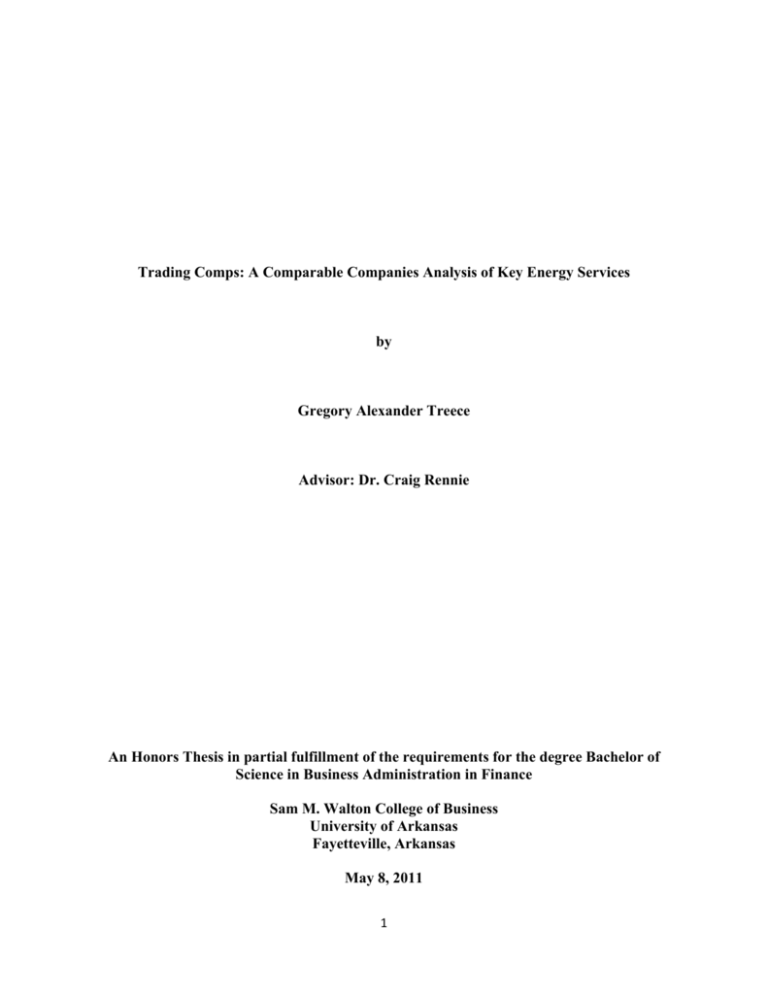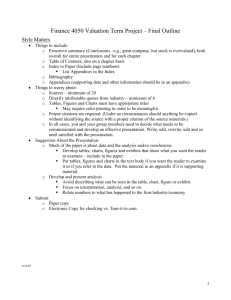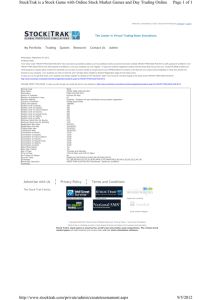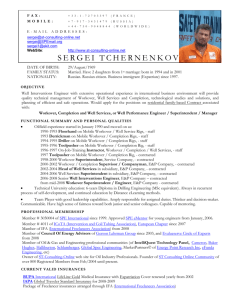A Comparable Companies Analysis of Key Energy Services by
advertisement

Trading Comps: A Comparable Companies Analysis of Key Energy Services by Gregory Alexander Treece Advisor: Dr. Craig Rennie An Honors Thesis in partial fulfillment of the requirements for the degree Bachelor of Science in Business Administration in Finance Sam M. Walton College of Business University of Arkansas Fayetteville, Arkansas May 8, 2011 1 Introduction As the world continues to quickly move towards a complex global economy, the realm of finance evolves rapidly with it—for better or for worse. However, no matter how complex finance becomes it always comes back to one simple principle: What’s it worth? The process of deriving worth, or value, is one of the central themes of finance. One of the primary valuation methodologies used to answer this question is called a comparable companies analysis (“trading comps” or “comparable companies”). In addition to trading comps, two other valuation methodologies are often used: precedent transaction analysis (“precedent transactions”) and discounted cash flow analysis (“DCF”). Trading comps, precedent transactions, and DCF are often used with and against each other to provide a checks and balances to the valuation process. A trading comp values a “target,” this can be a single company, business, collections of assets, or a certain division. With the target as a focal point, trading comps create a market benchmark that can be used to determine a relative valuation. The underlying principle behind benchmarking is the idea that similar companies share similar business properties, which makes them highly comparable. With the comparable business and financial characteristics, performance drivers and risks, you can position a target in terms of overall value. Trading comps are used by many finance professionals in a number of different focuses, but is particularly useful during mergers & acquisition scenarios, investment decisions, and initial public offerings. Unlike other valuation methods that result in an “intrinsic” value, (e.g. DCF) trading comps determines a “current” valuation that reflects contemporary market conditions. However useful, comparable companies analysis is not without its faults. The current valuation can become a shortfall when there are times of excessive irrationality in the market. In addition, since no two companies are the same there can be some interpretation as to whether similar but different companies can derive another company’s value accurately. Target background: Key Energy Services Before you can begin the steps necessary to complete a trading comp, you must learn the in-depth story of a target. Understanding the target is critical to accurately select comparables and carry out a valuation. Below in Exhibit 1 is a framework for studying the target and selecting comparable companies: Exhibit 1 Business Profile Financial Profile ● Sector ● Size ● Products and Services ● Profitability ● Customers and End Markets ● Growth Profile ● Distribution Channels ● Return on Investment ● Geography ● Credit Profile Rosenbaum, Pearl Key Energy Services (NYSE: KEG) is a small-cap oilfield services company based out of Maryland. Based on the number of rigs owned, Key is the largest onshore, rig-based well 2 servicing contractor. Key provides a range of services to oil companies, foreign national oil companies and independent oil and natural gas production companies, including rig-based well maintenance and workover services, well completion and recompletion services, fluid management services, fishing and rental services, and other ancillary oilfield services. In addition to a strong presence domestically, Key has operations in Mexico, Columbia, the Middle East, Russia and Argentina. They also have ownership interests in two oilfield services companies operating in Canada. Below in Exhibit 2 is an illustration showing Key’s service offerings. Exhibit 2 KEG Service Offerings Well Servicing Segment Production Services Rig-Based Services ▪ Maintenance Services ▪ Workover Services ▪ Completion Services ▪ Plugging and Abandonment Coiled Tubing Services Fishing and Rental Services Fluid Management Services Key’s service offerings are split between two segments: Well Servicing and Production Services. The largest portion of their Well Servicing segment is comprised of Rig-Based services. Key’s Rig-Based services include maintenance, workover, and recompletion of existing oil and natural gas wells, completion of newly drilled wells, and plugging and abandonment of wells which are no longer of use. Key also has the capability to offer specialty drilling services to both oil and gas producers—a service that is enhance by their proprietary KeyView® technology. In addition to Rig-Based services, Key also provides fluid management services in their well servicing segment. Maintenance Services are used during the whole life cycle of a natural gas or oil well. Some example of maintenance services that Key offers are routine mechanical repairs of pumps, tubing and other equipment, removal of debris and formation material from wellbores, and investigating downhole equipment for problems. Maintenance services are done quickly, usually being completed in less than 48 hours. According to Key, demand for maintenance services are correlated with the total number of producing oil and gas wells in a given market. Workover services are used to increase the production of existing wells, which is usually more complicated and time consuming than general maintenance services. Some examples of 3 typical workover services include deepening or extending wellbores by drilling horizontally or laterally, sealing off depleted zones, converting former production wells into injection wells and conducting major subsurface repairs. Due to their complex nature, workover services can last anywhere from several days to weeks. According to Key, demand for workover services are correlated with capital spending by oil and natural gas producers, which is affected by oil and gas prices. Generally speaking, Key sees an increase in workover services with high commodity prices and a decline with lower commodity prices. Completion and recompletion services are used to prepare newly drilled wells, or for older wells that have been worked over and are ready for production again. Key will usually provide a service rig which tests the zones and helps with installing downhole tubulars and equipment. Depending on the complexity of the completion it could take several days or weeks. According to Key, demand for completion and recompletion is correlated with drilling activity levels, which are in turn very sensitive to changes and expectations in commodity prices. Plugging and abandonment services are used to permanently close oil or gas wells that can no longer be used. According to Key, the demand for plugging and abandonment services is not as impacted by commodity prices as some of the other services because well operators are required by regulations to close wells that no longer produce. Fluid management services are used to provide transportation to the various fluids that are used in oilfield services. Some specific services include vacuum truck services, saltwater/non hydrocarbon transportation and disposal, and frac fluid storage. Fluids are removed from the site of production and taken to a saltwater disposal well that is owned by Key or one of its partners. At the end of December 2011 Key owned or leases 65 active saltwater wells. According to Key the demand for fluid management services is correlated with the demand for their well service rigs. Key’s Production Services segment has shrunk in terms of number of offerings since last year. Traditionally Key has offered pressure pumping (e.g. fracturing), wireline services, coiled tubing services and fishing and rental services. However, after selling its pressure pumping and wireline divisions to Patterson-UTI in early October of 2010, coiled tubing and fishing and rental is now their central focus in Production Services. Coiled tubing services are used in a number of ways that are useful to oil and gas companies. A coiled tube is essentially a continuous metal pipe spooled on a large reel that can clean out well bores, perform chemical treatments and fracture. Key’s coiled tubing business has 43 units, two-thirds of which possess the capability to assist in horizontal well completion due to their large diameter and extended reach. While Key currently only operates in the U.S. with their coiled tubing services, they anticipate an international expansion. Fishing and Rental Services are used for recovering lost equipment in the wells and renting equipment necessary for gas and oil operations. Key’s rentals includes drill pipe, handling tools, pressure-control equipment, power swivels and foam air units. 4 Comparable Companies Analysis: Five Steps With the critical due diligence stage of analyzing Key Energy Services completed, we can now embark on the steps necessary to complete to trading comp. Rosenbaum & Pearl’s Investment Banking details a five step process to performing a trading comp based on their years working in the industry and consulting with other investment banking professionals. The steps are listed below in Exhibit 3: Exhibit 3 Comparable Companies Analysis Steps Select the Universe of Comparable Companies Step I. Locate the Necessary Financial Information Step II. Spread Key Statistics, Ratios, and Trading Multiples Step III. Benchmark the Comparable Companies Step IV. Determine Valuation Step V. Rosenbaum, Pearl Step I. Select the Universe of Comparable Companies During our preliminary due diligence we were able to learn a substantial amount about Key Energy Services and the market it operates in: the oilfield services industry. We performed our due diligence primarily by searching through annual 10-Ks, quarterly 10-Qs, SEC filings, consensus research estimates, press releases and financial services websites. After studying Key, their prime competitors, and the oilfield services industry as a whole, we were able to come up with a list of large and small cap companies that we deemed “comparables”. These comparables share similar business characteristics such as: products and services offered, customers, end markets and financial profile. While comparables included in a trading comp may be very similar, they can never be exactly the same. These differences can be one of the weaknesses of a comparable companies analysis and they illustrate the need to have an investment banker who is both very knowledgeable about the target and the industry of operation. While performing a trading comp can be highly technical at times, it remains an art rather than a science. After reviewing a wide universe of potential companies the list of large cap comparables we selected were Schlumberger Ltd. (SLB), Halliburton Co. (HAL), Baker Hughes Inc. (BHI) and Weatherford International Ltd. (WFT). The list of small cap comparables we chose were RPC Inc. (RES), Superior Energy Services (SPN), Complete Production Services (CPX), Basic Energy Services (BAS), Tesco Corp (TESO), Newpark Resources (NR) and Parker Drilling Co. (PKD). The completed comparables list is illustrated below in Table 1 along with the equity value, enterprise value, and sales for the year ending in 2010. Although ultimately not all of these comparables will be included in the valuation, all will serve as a guide. 5 Table 1 ($ in millions, April 6, 2011 ) List of Comparable Companies Com pany Schlumberger Ltd Ticker SLB Business Description Supplier of technology, integrated project management and information solutions to customers w orking in the oil and gas industry. Enterprise Value Sales 120,857 124,196 27,447 Halliburton Co HAL Provides a range of services and products for the exploration, development, and production of oil and natural gas around the w orld. 42,706 44,651 17,973 Baker Hughes Inc BHI Supplier of oilfield services, products, technology and systems to the w orldw ide oil and natural gas industry. 29,942 32,464 14,414 Weatherford International Ltd WFT Provider of equipment and services used in the drilling, evaluation, completion, production and intervention of oil and natural gas w ells. 15,695 22,243 10,221 RPC Inc RES Provides a range of specialized oilfield services and equipment primarily to independent and oil and gas companies. 3,371 3,478 1,096 Superior Energy Services Inc SPN Diversified provider of specialized oilfield services and equipment. 3,068 3,881 1,682 Complete Production Services Inc CPX Provides specialized services and products focused on helping oil and gas companies to develop hydrocarbon reserves and enhance production. 2,207 2,797 1,561 Basic Energy Services Inc BAS Provides a range of w ell site services to oil and natural gas drilling and producing companies. 1,049 1,507 728 Tesco Corp TESO Engaged in the designing, manufacturing and service delivery of technology-based solutions for the upstream energy industry. 752 692 379 New park Resources Inc NR Diversified oil and gas industry supplier. Operates in three business segments: Fluids Systems and Engineering, Mats and Integrated Services, and Environmental Services. 654 746 716 Parker Drilling Co PKD Provider of contract drilling and drilling-related services. 788 1,209 659 6 Equity Value Step II. Locate the Necessary Financial Information The vast majority of the data in this report was compiled using Bloomberg Professional, with additional numbers coming from company 10-Ks and press releases. Bloomberg was especially useful in providing consensus earnings data, which provided the foundation for our future assumptions. Step III. Spread Key Statistics, Ratios, and Trading Multiples Key statistics, ratios, and trading multiples can vary significantly depending on the industry of operation. For the oilfield services industry and Key we decided to use the Price-toEarnings multiple (P/E ratio) and the Enterprise Value-to-EBITDA (EV/EBITDA) multiple. The P/E ratio is a very common trading multiple and it is calculated by taking the current share price and dividing it by the earnings per share (EPS). Similarly, we calculate P/E for future years by taking the current price and dividing it by future EPS estimates. The P/E ratio is a measure of how much investors are willing to pay for a dollar of a company’s current or future earnings. A company with a very high P/E ratio would more than likely also have very high earnings expectations and vice versa. Although the P/E ratio is commonly used in trading comps, it is not without its limitations. For companies with very little or no earnings it is not very useful. Another limitation is that since it is based off net income, (through EPS calculation) it can vary widely depending on capital structure. This means that two companies that are otherwise very comparable in an operating sense could have different P/E ratios due to the level of leverage. In order to offset the potential leverage issues that arise in P/E multiples, we also use Enterprise Value-to-EBITDA. EV/EBITDA is independent of capital structure, taxes and any depreciation & amortization effects. Having both P/E and EV/EBITDA gives us both a levered and unlevered look at the comparables. Step IV. Benchmark the Comparable Companies Once we have collected the necessary data for our comparables, we lay them out on an excel spreadsheet to calculate our desired trading multiples. Since we are using the P/E ratio and the EV/EBITDA ratio, it is important that we have the necessary components to create those multiples. In our benchmarking analysis we included equity value and EPS for our P/E calculation, enterprise value and EBITDA for our EV/EBITDA calculation. When we have these multiples side by side in a model format it makes for easy comparison, and “benchmarking”. This is illustrated in the benchmarking analysis shown on page 8. With the multiples calculated, we compute the mean and medians of both the large and small cap groups to get an average multiple for each. Finally, we calculate means and medians for the large and small cap groups combined. One of the advantages of separating the multiples in this fashion is that we can see how each group or single stock affects the entire comparable list of multiples. Now that we have successfully benchmarked the comparables, we can select the desired ranges to complete a valuation. 7 8








